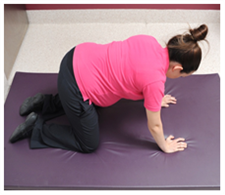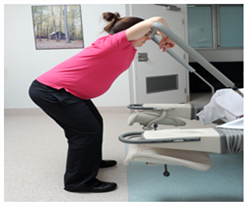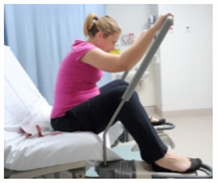Birth - frequently asked questions Guide
-
When does labour start?
A normal pregnancy lasts 38–42 weeks.
Every labour and birth is different. It is still not known exactly what happens to start labour.
The average length of pregnancy is 280 days or 40 weeks, from the first day of your last menstrual period. The medical term for the due date is estimated date of delivery (EDD).
Did you know that only about four percent of women give birth on their baby’s due date!
-
When will my waters break?
Most women’s waters break during labour, but it can also happen before labour starts.
When your waters break, the amniotic sac breaks, and the fluid drains out through your vagina. It can be a gush or a slow trickle.
The fluid will usually be clear but can be yellow or straw coloured. If it is green or red in colour, there may be a problem.
What should I do when my waters break?
Whatever the colour, you should put a pad on and call your midwife or the hospital who will advise you on when to come into hospital.
-
How long does labour last?
All labours are different. Every labour is unique. The length of each person’s labour is different.
How quickly your labour progresses will depend on the baby descending (going down through the pelvis) and the cervix dilating (opening up) with strong, regular contractions.
On average for your first baby, the:
- first stage of labour can last from 10 to 14 hours
- second stage of labour can take one to two hours to push your baby out
- third stage can last five to 45 minutes
- fourth stage is the first two hours after birth.
If you have had a baby before, the:
- first stage of labour can last from five to eight hours
- second stage can last from five minutes to an hour.
-
What is pre-labour?
For up to a week before labour starts, you may notice that your body is preparing for labour.
Some women will notice:
- an increase in vaginal discharge (clear)
- a plug of mucous (‘show’) may be released from the cervix – perhaps with a streak of blood
- feeling unusually energetic (nesting instinct)
- frequent Braxton Hicks ‘practice’ contractions.
-
What do contractions feel like?
Women describe and experience contractions in different ways.
They may feel like:
- lower abdominal cramps that feel like period pain
- persistent dull lower backache
- inner thigh pain that may run down your legs.
At first these contractions are short and may be far apart – sometimes as much as 30 minutes apart.
As your labour progresses, they will get longer, stronger and closer together; until they last for about a minute and are coming faster, about every two or three minutes.
-
How do I time contractions?
From the beginning of one contraction until the next one begins. You can also time how long the contractions last.
The frequency of your contractions
Using a watch or clock, measure the frequency of your contractions by timing them from the beginning of one to the beginning of the next.
True labour will develop into a regular pattern, with your contractions growing closer together. In false labour, contractions remain irregular.
The length of your contractions
Measure the duration of each contraction by timing when it begins and when it stops. True contractions last about 30 seconds at the onset and get progressively longer up to 75 seconds and stronger. False labour contractions vary in length and intensity.
-
When do I come to hospital?
Seek advice or come to hospital if:
- Your waters break – put on a sanitary pad, note the time, the colour and amount of water then call your midwife or the hospital.
- Your contractions become painful, regular and are occurring at least five minutes apart (this timing will depend on your personal history, circumstances and will be discussed in your pregnancy).
- Labour has commenced and you have been advised to attend hospital early.
- You are experiencing signs of labour and you have a planned caesarean birth.
- You have a known medical or pregnancy condition that means you will require closer monitoring than usual in labour
- Your baby’s movements have changed, or you are worried about your baby’s movements.
Call ‘000’ for an ambulance if:
- You think your labour is progressing very quickly and you won’t make it to hospital.
- You experience heavy bleeding (similar to first day of a period) or have a severe headache and blurred vision.
-
What do I bring to hospital?
See ‘Final preparations for labour’.
-
What happens when I get to hospital?
When you arrive, a midwife will talk about what is happening to you and discuss your birth preferences.
The midwife will:
- ensure you have an identification band on your wrist
- check your temperature, pulse and blood pressure
- check the baby’s position by feeling your abdomen
- listen to the baby’s heart rate
- time your contractions
- with your consent, may do an internal (vaginal) examination to see how much your cervix has opened, and to check the baby’s position.
-
What if my labour is progressing slowly?
What can I do if labour is progressing slowly?
It’s good if you can relax and stay calm – anxiety can slow things down.
The midwife may suggest:
- changing position
- walking around – movement can encourage contractions
- a warm shower or bath
- a back rub
- a nap to regain your energy
- something to eat or drink
- options for pain relief – if you’re very tired or have pain.
-
What is the best position for giving birth?
Kneeling, on the bed or floor, leaning against a large pile of pillows, or supported by a partner. Some women may feel more comfortable with one knee up.

Squatting, supported by partner behind, or holding onto a bar. The woman should stand to rest between contractions. This may not be appropriate for women who have had epidurals.

Sitting, such as on a toilet or birth stool, with the legs wide apart and leaning forwards with the arms supported on the thighs, or by a partner.

-
What is an episiotomy?
An episiotomy is a surgical cut in the woman’s perineum (area between the vagina and anus) during birth.
You may need an episiotomy (with your consent) when for some reason, related to your baby or you, your doctor or midwife believes there is a chance that your perineum may tear when the baby’s head comes through during the second stage of labour. This is more likely to occur when forceps or a vacuum assistance is required.
Research has shown that the selective use of episiotomy may reduce a more severe vaginal or perineal tear.
-
How will my baby be monitored during labour?
During labour, your baby's heart rate will be checked regularly.
If you have had a healthy pregnancy and there are no problems at the onset of labour, your baby's heart will be listened to every 15 to 30 minutes using a small hand-held Doppler ultrasound device. This equipment can be used regardless of the position you are in, even in the shower.
If you had problems during pregnancy or if problems arise during your labour, your baby’s heart rate may be monitored continuously using a cardiotocograph (CTG).
More information: Queensland Clinical Guidelines parent information – Fetal monitoring in labour
-
What is a CTG?
A CTG (cardiotocograph) involves having two plastic disks (receivers) strapped to your abdomen and held in place by two belts. The receivers are attached to a machine, which may limit your movement. Some machines are wireless, enabling you to move around freely while you are being monitored. This is known as telemetry.
-
Why do I need internal (vaginal) examinations?
What happens during a vaginal examination?
When a woman's cervix thins during labour it is referred to as effacing. When her cervix is opening it is called dilating.
These cervical changes can be measured by the caregiver doing a vaginal examination with their gloved fingers during labour, often referred to as a VE.
During labour, vaginal examinations are usually carried out after a contraction finishes and when the woman says she is ready.
-
Can I take my placenta home?
Request to take the placenta home
The birth placenta holds significant value in some cultures and for some people. It is not uncommon for people to bring their baby’s placenta home, bury it in the garden and plant a tree above it.
You have the right to take your placenta home – speak to your midwife about the policy and how the hospital will support you.
-
How do I register my baby’s birth?
After baby is born, you will be given a birth registration pack.
Information includes:
- how to register your baby’s birth
- how to order a birth certificate/extract or commemorative birth certificate.
In the case of same sex female parents, only one parent can be registered as the baby's mother.
More information:
Next section: When complications occur
Birth - frequently asked questions, 23 Mar 2023, [https://www.qldgovau.staging-services.qld.gov.au/health/children/pregnancy/antenatal-information/birth-frequently-asked-questions]
This document is uncontrolled when printed. Before using the information in this document you should verify the current content on https://www.qldgovau.staging-services.qld.gov.au/health/children/pregnancy/antenatal-information/birth-frequently-asked-questions.